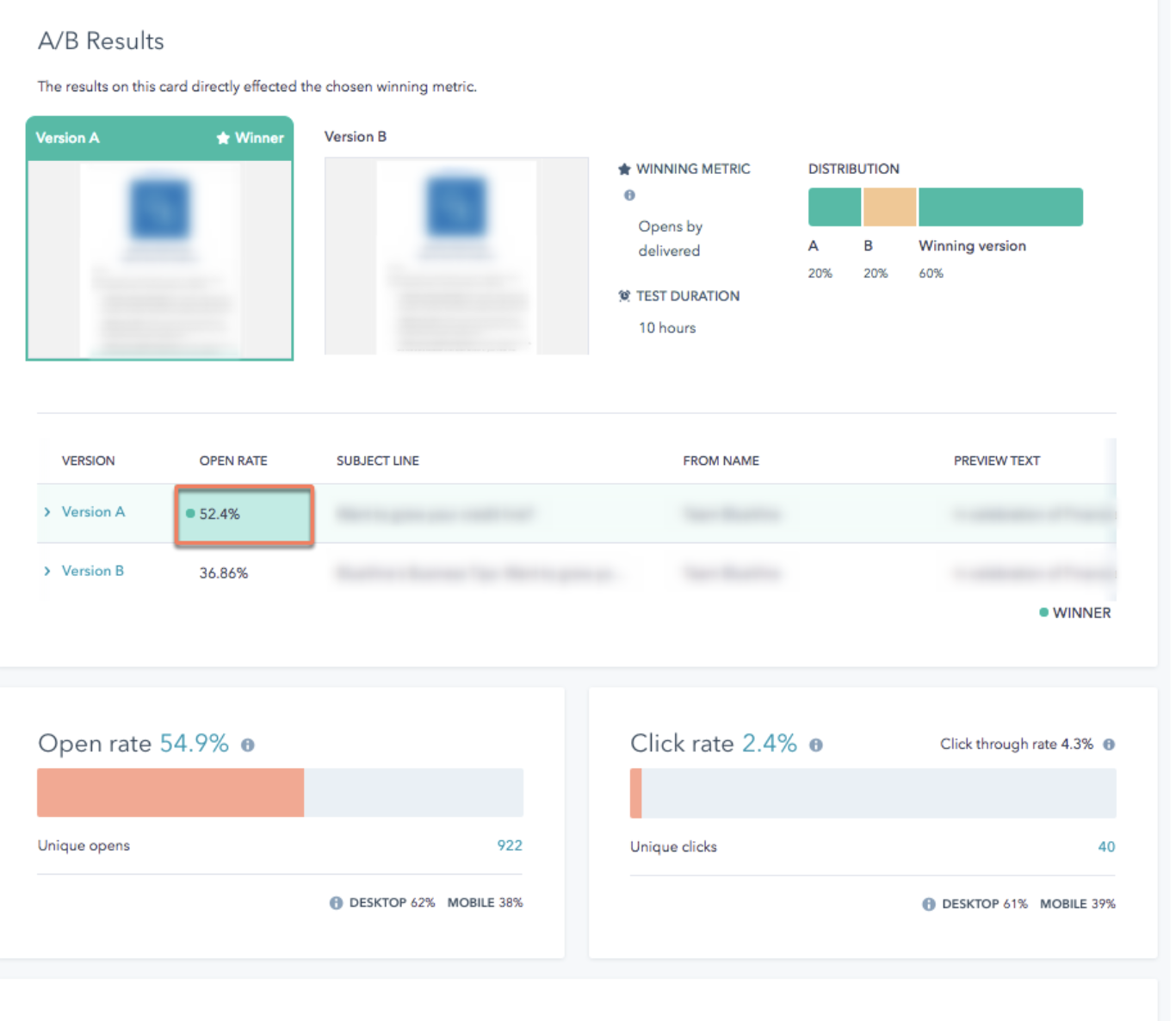In our continuous adventure for better, more engaging ways to communicate with audiences along their journey, A/B testing provides valuable, data-driven audience insight. A/B testing is a powerful tool for marketers, allowing them to optimize email campaigns for maximum engagement, based on experimental data. By sending different versions of the same email to an audience segment, marketers can compare how the variations impact metrics like email opens and clicks. That’s why over 93% of US companies utilize A/B testing for their email marketing campaigns. A/B testing allows marketers to make data-driven decisions to enhance their email marketing strategies.
The Benefits of A/B Testing
At its core, A/B testing is about exploring the best ways to reach your audience and learning from the data you collect. Performing A/B testing allows you to answer questions about your audience specifically, everything is testable. One of the most rewarding benefits of A/B testing is that it showcases the concreteness of your marketing strategy, providing actionable ways for you to keep developing. Research shows successful A/B testing can bring a 50% increase in the average revenue per unique visitor for e-commerce sites.
Learning from real examples of audience behavior eliminates guesswork. When you know what works with your audience (and what doesn’t) you can tailor your messaging for them. This leads to higher engagement, better conversion rates, and ultimately, a stronger return on investment (ROI).
9 Tips for A/B Testing Emails in HubSpot
A/B testing emails in HubSpot can help you improve the results of your email campaigns. Take HubSpot itself for example; the company used A/B testing to check the effects of one of their personalized email campaigns. In series A, they used the unique sender’s name, and the generic company name in series B. Series A, which was more personalized, reached a 0.53% higher open rate and 0.23% higher click-through rate. This might seem like a small percentage, however, the difference led to 131 new leads. Get in on HubSpot’s success by conducting effective A/B tests with these 9 tips.
- Define your goal: Precisely define the goal of your A/B test. Whether it’s increasing open, click-through, or conversion rates, having a clear goal helps you design your tests with purpose. Get as nitty gritty as you can: Are you focused on testing unique subject lines, email layouts, CTAs, or sender names? Creating a detailed plan for your initiatives will help you effectively structure your A/B testing experiment.
- Choose a single variable: Make sure you are taking things one step at a time, and focus on testing a single element per test so you can isolate its impact on the performance of a campaign. You can test anything from the subject line, email content, layout, and images, to even the CTA. If you were to test multiple of these variables at the same time, it would be impossible to pinpoint the reason for any sort of changes in performance. Testing one variable at a time allows you to identify the exact factor affecting your results, making it easier to analyze and implement changes based on your findings.
- Divide your audience: Split your audience into two or more groups and randomly assign each group to different variations of the email. Yes, this concept is called A/B testing, but it might as well be A/Z testing, am I right? HubSpot allows you to create multiple email variations within a single email campaign. Splitting your audience into distinct groups allows you to be confident in your results, knowing that they are unbiased. Randomly assigning each group to different variations helps eliminate any additional chance of potential biases.

- Determine the sample size: The confidence you have in the results depends on the strength of your sample size. Larger sample sizes usually provide more reliable data but may require more time and resources, so it’s about finding the balance. The size of the email list you’re performing tests on determines the statistical significance you’ll gain. With this being said, it’s crucial that every version of your email reaches an ample audience, so you can form reliable conclusions based on the results. HubSpot offers options to determine what percentage of your audience should be receiving each variation.
- Monitor performance metrics: Performance metrics like open rates, click-through rates, and conversion rates are the heartbeat of your campaign, so use them to evaluate the success of your tests. Keeping a close eye on the key metrics will reveal which variation is performing better and why this is the case. HubSpot makes tracking these metrics easy by providing detailed email campaign analytics.
- Determine the winner: Let your A/B test run long enough to gather adequate data. HubSpot allows you to set a predefined period or sample size threshold before it automatically determines a winner based on your chosen metric.
- Analyze the results: Once your A/B test is done, analyze the results to determine which variation performed better. When looking at results, consider the significance of the data and the extent of performance differences. It’s important to remember that a small improvement may be statistically significant but not meaningful in a practical sense.
- Apply the winning variation: Take note of the insights gained from A/B tests and apply them to refine your overall email marketing strategy. Once you've identified a winning variation, incorporate it into your future email campaigns. Learn from the insights gained during the A/B test to refine your overall strategy.
- Continue testing: Continue testing different variables and iterations to continuously optimize your email marketing efforts and improve results. Remember, A/B testing is an ongoing process. As your audience and market evolve, so should your email campaigns. Continuously test different variables and iterations to stay competitive and improve results over time.
How to A/B Test Emails in HubSpot
A/B testing pushes you to explore creative ideas and new strategies. It’s not just about optimizing a single email; it's about refining your email marketing strategy as a whole, adapting to evolving audience tastes and industry trends.
A/B testing in HubSpot can take your email campaigns to the next level when you know what you’re doing. By following these steps, you can effectively conduct A/B tests on your marketing emails to determine which variations perform better and make decisions backed by results to elevate your email campaigns. These are the fundamental steps that will guide you through the process of conducting A/B tests for your campaigns using our favorite tool, HubSpot.
1. Access Your HubSpot Account: First things first, log in to your HubSpot account. Head to the "Marketing" section and make your way to the "Email" tab.
2. Create Version A: Start by creating the first rendition of your email. This will serve as "Version A" in your A/B test.
3. Start A/B Test: In the email editor, click on "Create A/B test" in the top left corner. This action will cue you to name the “Variation B” email, which is, you guessed it, the second rendition of your email.
4. Edit Variations: Now, you can edit both variations (A and B) of your email. Experiment with different elements, including offers, copy, email sender, images, subject lines, or even the entire email content to see how these tweaks impact your engagement levels.
5. A/B Test Settings: Click on the "Settings" tab to configure your A/B test options:
 A/B Distribution: Decide what percentage of your contact list will receive “Version A” and “Version B.” You can either split it evenly down the middle (50/50) or go a route of your own.
A/B Distribution: Decide what percentage of your contact list will receive “Version A” and “Version B.” You can either split it evenly down the middle (50/50) or go a route of your own.- Winning Metric: Choose the metric that will determine the winning variation. This can be the open, or click-through rate for starters.
- Test Duration: Set a time period to gather data before selecting a winner. If results are inconclusive after this period, HubSpot will automatically send “Variation A” to the rest of your recipients.
6. Cancel A/B Test: If a challenge arises and you need to cancel your A/B test, you can by going to the "Email" section, selecting the A/B email, and using the "Actions" dropdown menu. You can cancel the test even if it's still processing or hasn't determined a winner.
7. Analyze Results: After sending the A/B test emails and waiting an adequate period of time to compile results, you can explore the performance analytics on the "Performance" page. Hubspot even highlights the winning version and metric for you in green.
You can look at your campaign from the beginning by clicking on "See details" at the top of the page. Reviewing your original A/B test configuration will help you gain further insight into the test results.
With its user-friendly interface and strong analytics, A/B testing becomes a breeze with HubSpot on your team, allowing you to refine your email campaigns smoothly. A/B testing is not a finish line; it's a journey of improvement. So, as the market and your audience ebb and flow, let your campaigns adapt and evolve with them. By continually exploring new ways to challenge marketing norms, you'll be at the top of your game.




